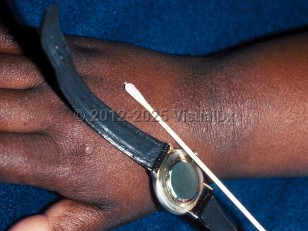Allergic contact dermatitis (pediatric) in Infant/Neonate
See also in: AnogenitalAlerts and Notices
Important News & Links
Synopsis

This summary discusses pediatric patients. Allergic contact dermatitis in adults is addressed separately.
Contact dermatitis can be due to either allergic or irritant causes. Irritant contact dermatitis is due to nonimmunologic local exposure of the skin to an irritating substance. Allergic contact dermatitis is a cutaneous inflammatory process (type IV cell-mediated or delayed hypersensitivity reaction) usually localized to areas where allergens contact the skin. Beyond the area of primary contact, a secondary dermatitis may develop. Initial sensitization and development of cutaneous inflammation takes 1-4 weeks; however, repeat exposure produces reactions within 48 hours or less.
In children, allergic contact dermatitis is more common after the age of 5 years, but younger children can become sensitized. An estimated 4.4 million children are affected by contact dermatitis in the United States. Allergic contact dermatitis is rare in infants but can be induced as early as the neonatal period.
Diapers, powder, creams, and products used in toileting may instigate contact dermatitis in infants and toddlers. Infants requiring supplemental nutrition via a stoma may develop irritant dermatitis to adhesives. Areas under occlusion or with active erosion are at higher risk for allergen penetration and subsequent allergic contact dermatitis.
Related topic: diaper irritant contact dermatitis
Contact dermatitis can be due to either allergic or irritant causes. Irritant contact dermatitis is due to nonimmunologic local exposure of the skin to an irritating substance. Allergic contact dermatitis is a cutaneous inflammatory process (type IV cell-mediated or delayed hypersensitivity reaction) usually localized to areas where allergens contact the skin. Beyond the area of primary contact, a secondary dermatitis may develop. Initial sensitization and development of cutaneous inflammation takes 1-4 weeks; however, repeat exposure produces reactions within 48 hours or less.
In children, allergic contact dermatitis is more common after the age of 5 years, but younger children can become sensitized. An estimated 4.4 million children are affected by contact dermatitis in the United States. Allergic contact dermatitis is rare in infants but can be induced as early as the neonatal period.
Diapers, powder, creams, and products used in toileting may instigate contact dermatitis in infants and toddlers. Infants requiring supplemental nutrition via a stoma may develop irritant dermatitis to adhesives. Areas under occlusion or with active erosion are at higher risk for allergen penetration and subsequent allergic contact dermatitis.
Related topic: diaper irritant contact dermatitis
Codes
ICD10CM:
L23.9 – Allergic contact dermatitis, unspecified cause
SNOMEDCT:
238575004 – Allergic contact dermatitis
L23.9 – Allergic contact dermatitis, unspecified cause
SNOMEDCT:
238575004 – Allergic contact dermatitis
Look For
Subscription Required
Diagnostic Pearls
Subscription Required
Differential Diagnosis & Pitfalls

To perform a comparison, select diagnoses from the classic differential
Subscription Required
Best Tests
Subscription Required
Management Pearls
Subscription Required
Therapy
Subscription Required
References
Subscription Required
Last Reviewed:08/03/2021
Last Updated:08/04/2021
Last Updated:08/04/2021
 Patient Information for Allergic contact dermatitis (pediatric) in Infant/Neonate
Patient Information for Allergic contact dermatitis (pediatric) in Infant/Neonate
Premium Feature
VisualDx Patient Handouts
Available in the Elite package
- Improve treatment compliance
- Reduce after-hours questions
- Increase patient engagement and satisfaction
- Written in clear, easy-to-understand language. No confusing jargon.
- Available in English and Spanish
- Print out or email directly to your patient
Upgrade Today

Allergic contact dermatitis (pediatric) in Infant/Neonate
See also in: Anogenital
